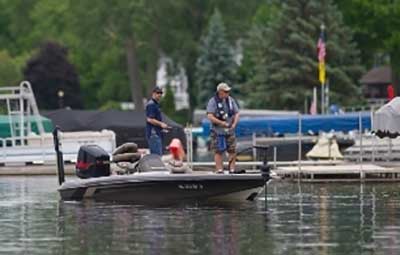By Louie Stout
 Regulation Reveals How Popular Bass Tournaments AreThe Michigan DNR once poo-pooed the notion that bass tournaments and bass fishing in general were a big deal in the state.
Regulation Reveals How Popular Bass Tournaments AreThe Michigan DNR once poo-pooed the notion that bass tournaments and bass fishing in general were a big deal in the state.
After all, Michigan is about trout, salmon, walleye and panfish, right?
But since a new program was launched two years ago requiring bass tournament groups register their events, state officials are finding out it’s a lot more popular than once believed.
Tournament groups are required by law to register every event and report their catches. Those that don’t could be charged with a misdemeanor and face a fine.
The Michigan DNR has been blown away by the response and the information it has gathered. Tournament anglers have embraced it.
Tom Goniea, the DNR’s tournament fishing liaison, said most northern state agencies don’t do a lot of bass management, assuming natural lake bass populations take care of themselves, so they spend time on other species.
That thought process is changing in the Wolverine State.
“This has really made us aware of just how popular tournament fishing is,” he said. “Prior to the program, people only talked about how important tournaments were to the economy, but now we see just how important the activity is to our resident anglers as well as those coming in from out of state.”
Last year, for example, there were nearly 2,500 tournaments held statewide, an increase of about 400 from the year before. Bass groups utilized 275 different bodies of water within 70 of Michigan’s 83 counties, most of which were in the southern Lower Peninsula. The tournaments averaged 25 anglers fishing from 13 boats.
Lake St. Clair near Detroit led the list with 80 tournaments while Austin Lake in Kalamazoo was second with 65. Other popular lakes familiar to Michiana anglers include Klinger Lake which ranked ninth with 34 and Paw Paw Lake which ranked 12th with 29.
In addition, Goniea has learned that between 8 and 12 percent of the tournaments – about 200 - are coming in from outside Michigan a year.
“That tells us how many out-of-state anglers are being attracted here to fish tournaments and that’s bringing new money into the state, since those guys probably wouldn’t be fishing here if it weren’t for the tournaments,” he said.
But keeping track of the numbers of events is only part of the equation. Tournament Directors are required to fill out forms listing number of anglers, boats, number of fish weighed in, total weight of fish, number of fish over 4 pounds and the heaviest fish.
Last year, the average statewide catch was 1.6 fish per angler and tournament fish averaged 2.2 pounds. Statewide, tournament anglers reported catching and releasing 43 bass exceeding 6 pounds.
The biggest fish caught and reported by directors was an 8 pounder from Sand Lake in Lenawee County last July.
As interesting as those stats are, what’s important here is that fish managers are gaining some valuable data that previously wasn’t available to them or would take years to assimilate.
As more years of data are accumulated, it will become an even bigger tool for fish managers.
“We’re still in our infancy but biologists are already including some of the results in their lake reports,” said Goniea. “But I can tell you this – the program is a monumental success as far as the popularity with tournament directors and the information we’re getting is phenomenal.”
So phenomenal, in fact, that Goniea made a presentation to other state agencies at the Bassmaster Classic Conservation Summit in South Carolina in March.
“There was a tremendous interest from other states in our program and I’ve been contacted by several (fish agencies) who are laying plans to build their own programs based on what we are doing,” said Goniea. It’s been widely praised because it forms a partnership among tournament anglers, state regulators and the DNR.”
Michigan spent $200,000 investment initially to set up the computerized online reporting system (www.michigan.gov/fishingtournaments) and another $50,000 for improvements to pave the way for inclusion of walleye, muskie and bow fishing tournaments that are required to be reported next year.
There should be very little cost from here on in.
What about Indiana?
The Hoosier DNR has a watered down program that is limited to 11 lakes, most of which are state reservoirs in the south. In northern Indiana, only tournaments of 15 boats or more held on Wawasee, Syracuse or Sylvan lakes are required to report.
Michigan’s broader program could provide a huge benefit to northern Hoosier fish managers who have to manage so many natural lakes with such a small staff.


